
F5 (FFIV)
We’re cautious of F5. Its growth has been lacking and its cash conversion is projected to decline, a situation we’d avoid.― StockStory Analyst Team
1. News
2. Summary
Why We Think F5 Will Underperform
Originally named after the F5 tornado, the most powerful on the meteorological scale, F5 (NASDAQ:FFIV) provides security and delivery solutions that protect applications across cloud, data center, and edge environments for large organizations.
- Estimated sales growth of 1.6% for the next 12 months implies demand will slow from its two-year trend
- Customers were hesitant to make long-term commitments to its software as its ARR averaged 12.3% declines over the last year
- A consolation is that its healthy operating margin shows it’s a well-run company with efficient processes, and its rise over the last year was fueled by some leverage on its fixed costs


F5 doesn’t meet our quality standards. There are more promising prospects in the market.
Why There Are Better Opportunities Than F5
High Quality
Investable
Underperform
Why There Are Better Opportunities Than F5
At $242.85 per share, F5 trades at 4.5x forward price-to-sales. F5’s valuation may seem like a great deal, but we think there are valid reasons why it’s so cheap.
We’d rather pay up for companies with elite fundamentals than get a bargain on weak ones. Cheap stocks can be value traps, and as their performance deteriorates, they will stay cheap or get even cheaper.
3. F5 (FFIV) Research Report: Q3 CY2025 Update
Application security provider F5 (NASDAQ:FFIV) beat Wall Street’s revenue expectations in Q3 CY2025, with sales up 8.5% year on year to $810.1 million. On the other hand, next quarter’s revenue guidance of $755 million was less impressive, coming in 4.7% below analysts’ estimates. Its non-GAAP profit of $4.39 per share was 10.6% above analysts’ consensus estimates.
F5 (FFIV) Q3 CY2025 Highlights:
- Revenue: $810.1 million vs analyst estimates of $794.1 million (8.5% year-on-year growth, 2% beat)
- Adjusted EPS: $4.39 vs analyst estimates of $3.97 (10.6% beat)
- Adjusted Operating Income: $299.4 million vs analyst estimates of $286.9 million (37% margin, 4.4% beat)
- Revenue Guidance for Q4 CY2025 is $755 million at the midpoint, below analyst estimates of $792.4 million
- Adjusted EPS guidance for Q4 CY2025 is $3.60 at the midpoint, below analyst estimates of $4.03
- Operating Margin: 25.4%, in line with the same quarter last year
- Free Cash Flow Margin: 23.7%, down from 35.1% in the previous quarter
- Billings: $851.6 million at quarter end, up 10.3% year on year
- Market Capitalization: $17.14 billion
Company Overview
Originally named after the F5 tornado, the most powerful on the meteorological scale, F5 (NASDAQ:FFIV) provides security and delivery solutions that protect applications across cloud, data center, and edge environments for large organizations.
F5's multicloud strategy addresses the complexity of modern IT landscapes where applications and data exist in multiple environments simultaneously. The company's product families include F5 Distributed Cloud Services, F5 NGINX, and F5 BIG-IP, each targeting specific needs in application security and delivery. Distributed Cloud Services offers SaaS-based solutions like Web App and API Protection (WAAP) with capabilities including web application firewalls, DDoS mitigation, and bot defense. The NGINX portfolio, built from widely-used open source software, provides lightweight solutions for modern containerized applications. BIG-IP products focus on traditional applications with comprehensive security and delivery features.
For enterprise customers managing a mix of legacy and modern applications, F5's solutions enable consistent security policies and performance optimization regardless of where applications are deployed. A financial services firm, for example, might use F5's technology to protect customer-facing banking applications from sophisticated attacks while ensuring responsive performance across global data centers and cloud environments.
F5 monetizes its technology through various models: perpetual licenses, subscriptions, usage-based consumption, and hardware systems enhanced with proprietary software. The company complements its product portfolio with services including maintenance, consulting, and technical support, operating globally with particular focus on Americas, EMEA, and APAC regions.
4. Content Delivery
The amount of content on the internet is exploding, whether it is music, movies and or e-commerce stores. Consumer demand for this content creates network congestion, much like a digital traffic jam which drives demand for specialized content delivery networks (CDN) services that alleviate potential network bottlenecks.
F5 competes with Citrix and Broadcom in application delivery, cloud providers like AWS and Google in cloud-native traffic management, and security specialists including Akamai, Cloudflare, Fortinet, and Palo Alto Networks in application security and DDoS protection.
5. Revenue Growth
A company’s long-term sales performance is one signal of its overall quality. Any business can have short-term success, but a top-tier one grows for years. Over the last five years, F5 grew its sales at a weak 5.5% compounded annual growth rate. This fell short of our benchmark for the software sector and is a rough starting point for our analysis.

Long-term growth is the most important, but within software, a half-decade historical view may miss new innovations or demand cycles. F5’s annualized revenue growth of 4.8% over the last two years aligns with its five-year trend, suggesting its demand was consistently weak. 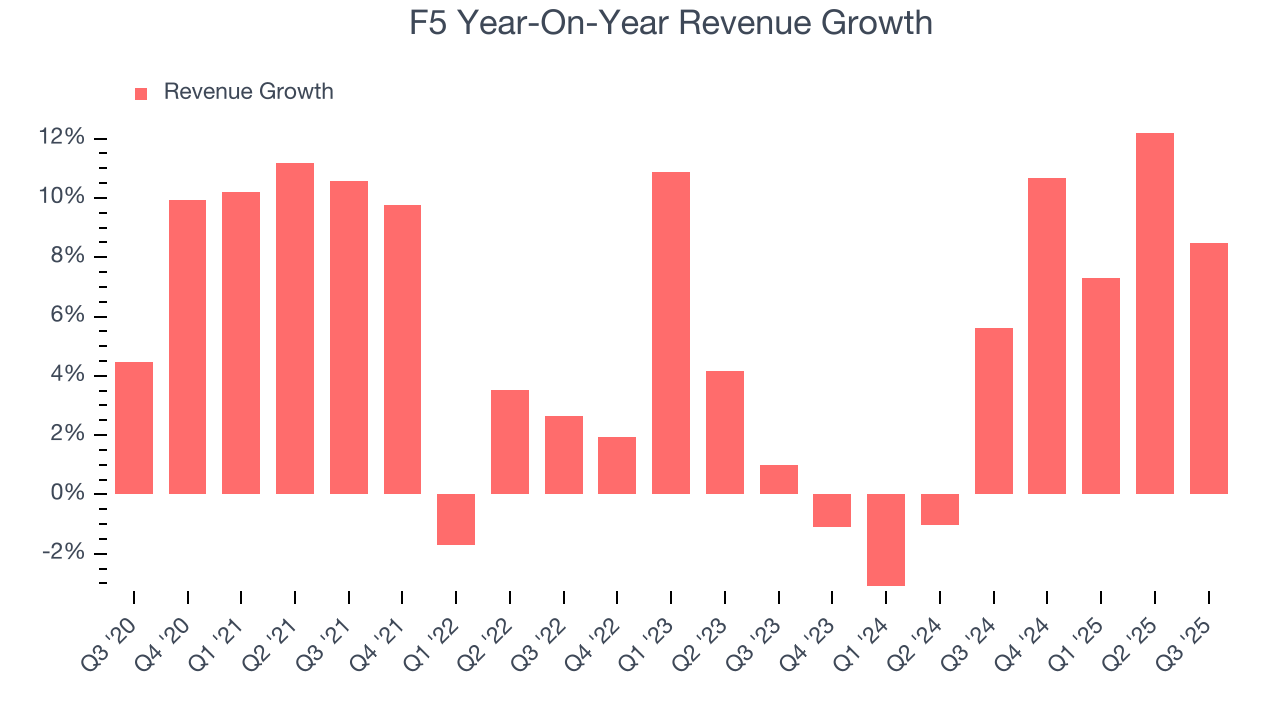
This quarter, F5 reported year-on-year revenue growth of 8.5%, and its $810.1 million of revenue exceeded Wall Street’s estimates by 2%. Company management is currently guiding for a 1.5% year-on-year decline in sales next quarter.
Looking further ahead, sell-side analysts expect revenue to grow 3.7% over the next 12 months, similar to its two-year rate. This projection is underwhelming and suggests its products and services will see some demand headwinds.
6. Billings
Billings is a non-GAAP metric that is often called “cash revenue” because it shows how much money the company has collected from customers in a certain period. This is different from revenue, which must be recognized in pieces over the length of a contract.
F5’s billings punched in at $851.6 million in Q3, and over the last four quarters, its growth slightly outpaced the sector as it averaged 15.9% year-on-year increases. This alternate topline metric grew faster than total sales, meaning the company collects cash upfront and then recognizes the revenue over the length of its contracts - a boost for its liquidity and future revenue prospects. 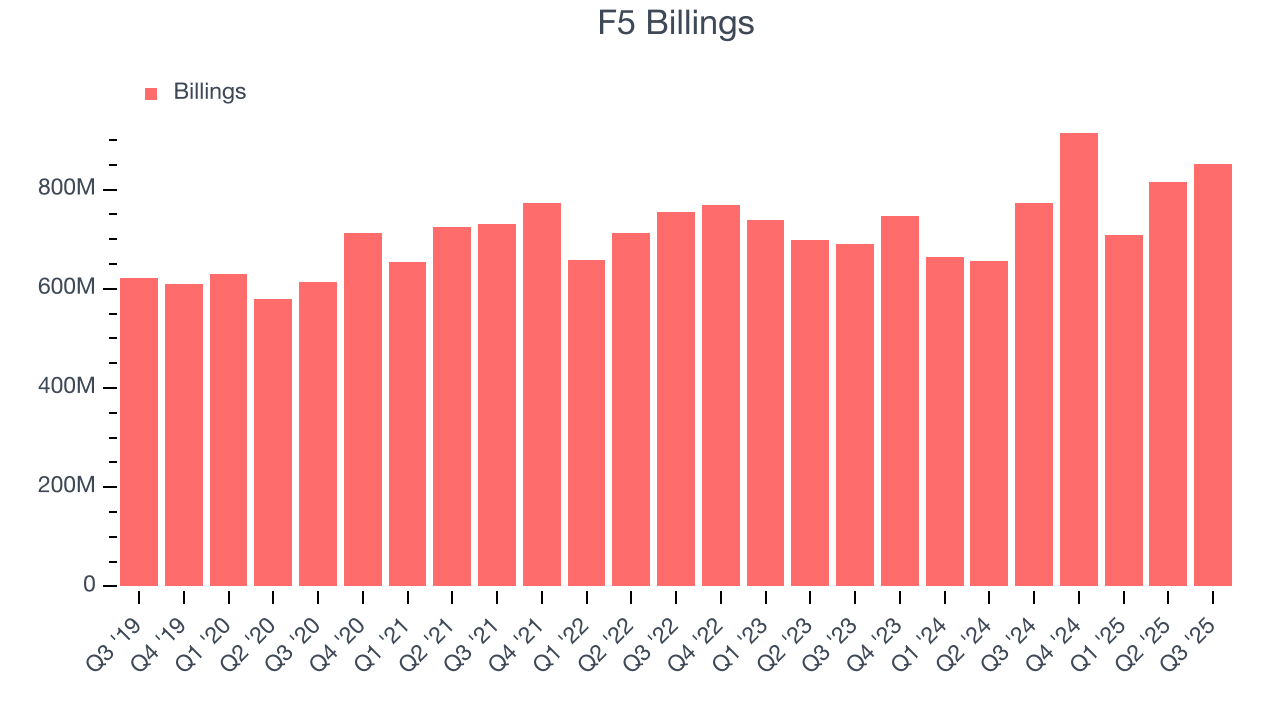
7. Customer Acquisition Efficiency
The customer acquisition cost (CAC) payback period represents the months required to recover the cost of acquiring a new customer. Essentially, it’s the break-even point for sales and marketing investments. A shorter CAC payback period is ideal, as it implies better returns on investment and business scalability.
F5 is extremely efficient at acquiring new customers, and its CAC payback period checked in at 15.5 months this quarter. The company’s rapid recovery of its customer acquisition costs indicates it has a highly differentiated product offering and a strong brand reputation. These dynamics give F5 more resources to pursue new product initiatives while maintaining the flexibility to increase its sales and marketing investments.
8. Gross Margin & Pricing Power
For software companies like F5, gross profit tells us how much money remains after paying for the base cost of products and services (typically servers, licenses, and certain personnel). These costs are usually low as a percentage of revenue, explaining why software is more lucrative than other sectors.
F5’s robust unit economics are better than the broader software industry, an output of its asset-lite business model and pricing power. They also enable the company to fund large investments in new products and sales during periods of rapid growth to achieve higher profits in the future. As you can see below, it averaged an excellent 81.4% gross margin over the last year. That means F5 only paid its providers $18.59 for every $100 in revenue.
The market not only cares about gross margin levels but also how they change over time because expansion creates firepower for profitability and free cash generation. F5 has seen gross margins improve by 2.5 percentage points over the last 2 year, which is very good in the software space.
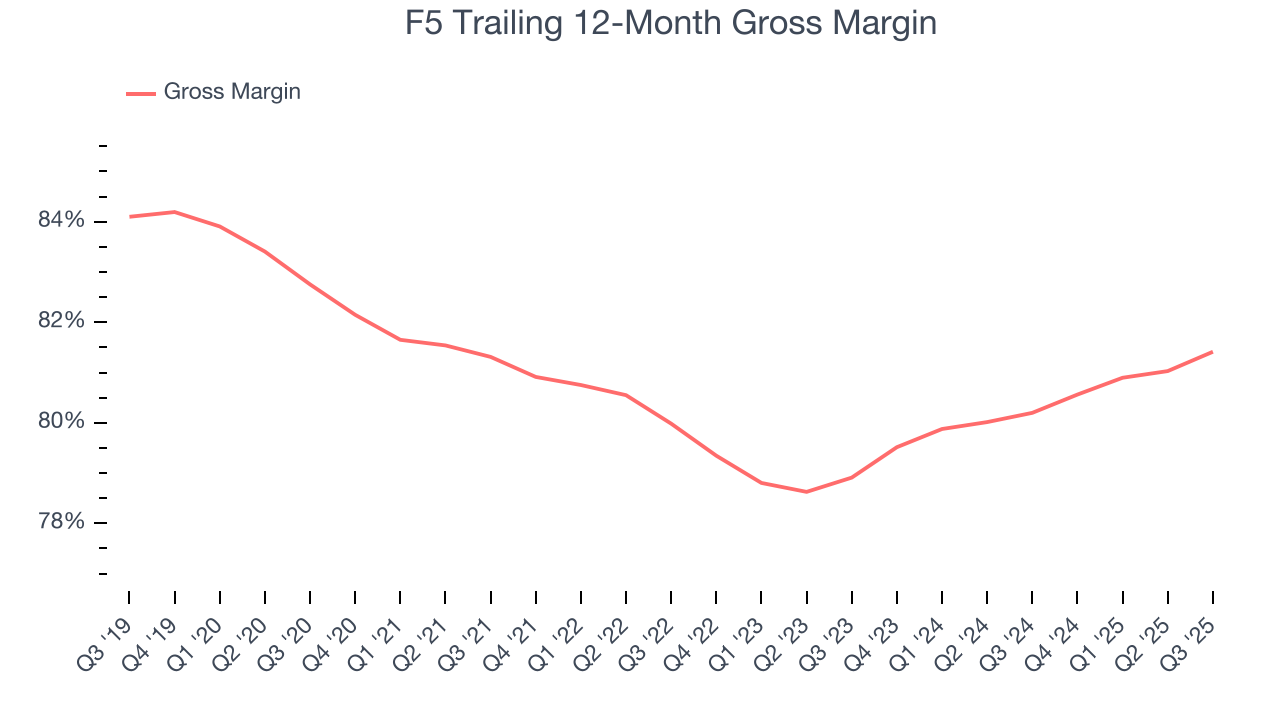
This quarter, F5’s gross profit margin was 82.2%, up 1.5 percentage points year on year. F5’s full-year margin has also been trending up over the past 12 months, increasing by 1.2 percentage points. If this move continues, it could suggest better unit economics due to more leverage from its growing sales on the fixed portion of its cost of goods sold (such as servers).
9. Operating Margin
While many software businesses point investors to their adjusted profits, which exclude stock-based compensation (SBC), we prefer GAAP operating margin because SBC is a legitimate expense used to attract and retain talent. This metric shows how much revenue remains after accounting for all core expenses – everything from the cost of goods sold to sales and R&D.
F5 has been a well-oiled machine over the last year. It demonstrated elite profitability for a software business, boasting an average operating margin of 24.8%. This result isn’t surprising as its high gross margin gives it a favorable starting point.
Analyzing the trend in its profitability, F5’s operating margin rose by 1.4 percentage points over the last two years, as its sales growth gave it operating leverage.

In Q3, F5 generated an operating margin profit margin of 25.4%, in line with the same quarter last year. This indicates the company’s cost structure has recently been stable.
10. Cash Is King
Although earnings are undoubtedly valuable for assessing company performance, we believe cash is king because you can’t use accounting profits to pay the bills.
F5 has shown robust cash profitability, driven by its attractive business model and cost-effective customer acquisition strategy that enable it to invest in new products and services rather than sales and marketing. The company’s free cash flow margin averaged 29.4% over the last year, quite impressive for a software business.
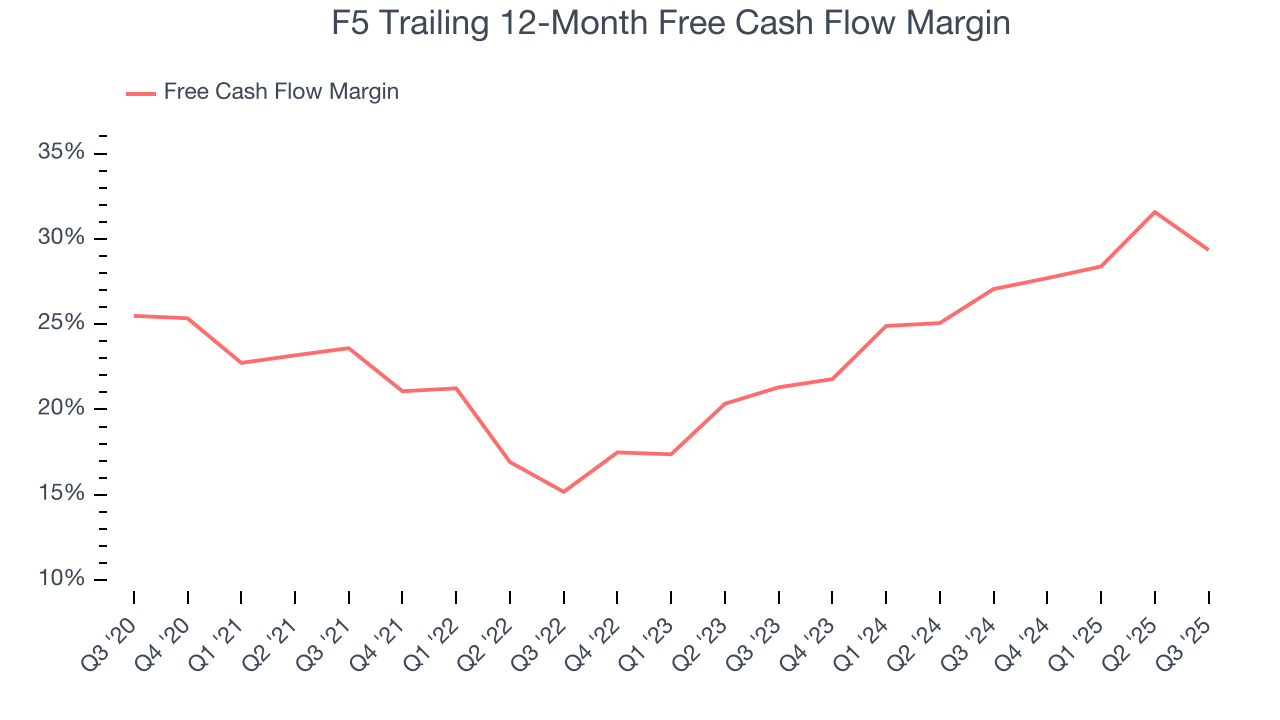
F5’s free cash flow clocked in at $191.9 million in Q3, equivalent to a 23.7% margin. The company’s cash profitability regressed as it was 8.5 percentage points lower than in the same quarter last year, prompting us to pay closer attention. Short-term fluctuations typically aren’t a big deal because investment needs can be seasonal, but we’ll be watching to see if the trend extrapolates into future quarters.
Over the next year, analysts predict F5’s cash conversion will improve. Their consensus estimates imply its free cash flow margin of 29.4% for the last 12 months will increase to 32.6%, giving it more flexibility for investments, share buybacks, and dividends.
11. Balance Sheet Assessment
Businesses that maintain a cash surplus face reduced bankruptcy risk.
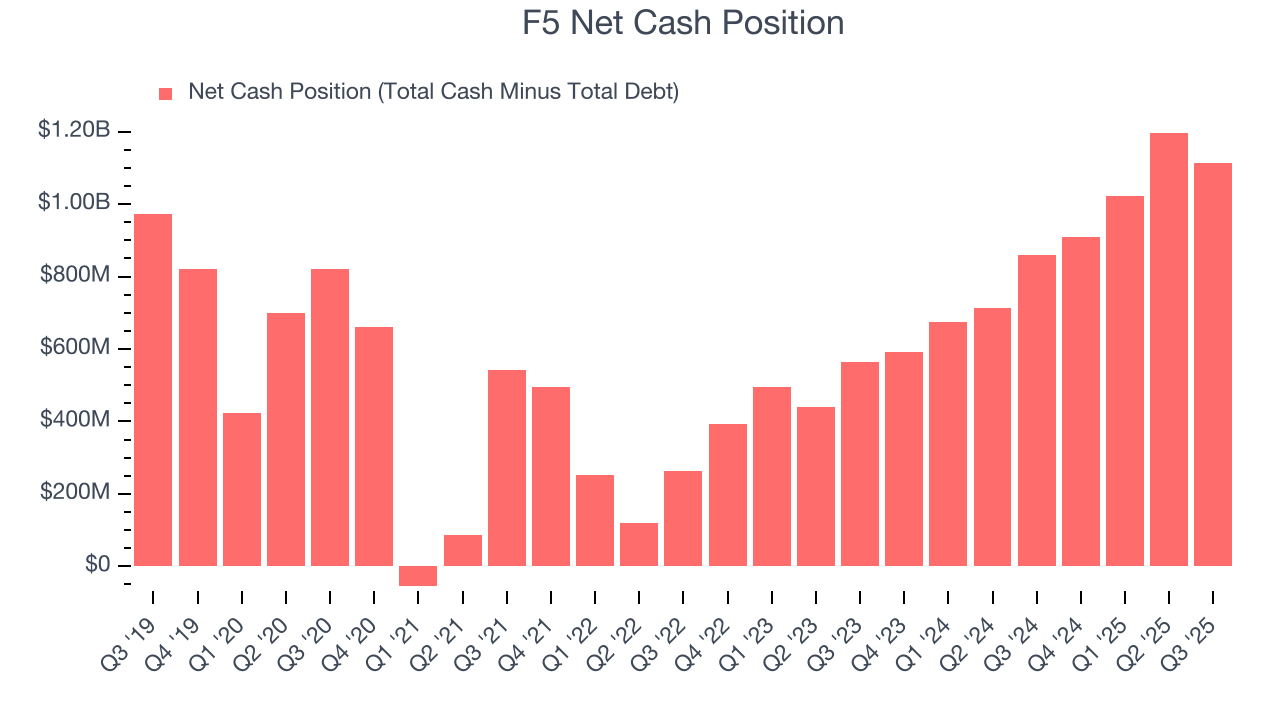
F5 is a profitable, well-capitalized company with $1.34 billion of cash and $230.7 million of debt on its balance sheet. This $1.11 billion net cash position is 6.7% of its market cap and gives it the freedom to borrow money, return capital to shareholders, or invest in growth initiatives. Leverage is not an issue here.
12. Key Takeaways from F5’s Q3 Results
We were impressed by how significantly F5 blew past analysts’ billings expectations this quarter. We were also happy its revenue outperformed Wall Street’s estimates. On the other hand, its revenue guidance for next quarter missed and its EPS guidance for next quarter fell short of Wall Street’s estimates. Overall, this was a weaker quarter. The stock traded down 5.4% to $274.79 immediately following the results.
13. Is Now The Time To Buy F5?
Updated: December 4, 2025 at 9:23 PM EST
When considering an investment in F5, investors should account for its valuation and business qualities as well as what’s happened in the latest quarter.
F5 isn’t a terrible business, but it doesn’t pass our quality test. For starters, its revenue growth was weak over the last five years, and analysts expect its demand to deteriorate over the next 12 months. And while its impressive operating margins show it has a highly efficient business model, the downside is its ARR has disappointed and shows the company is having difficulty retaining customers and their spending. On top of that, its expanding operating margin shows it’s becoming more efficient at building and selling its software.
F5’s price-to-sales ratio based on the next 12 months is 4.5x. While this valuation is reasonable, we don’t really see a big opportunity at the moment. We're fairly confident there are better investments elsewhere.
Wall Street analysts have a consensus one-year price target of $291.50 on the company (compared to the current share price of $242.85).
Although the price target is bullish, readers should exercise caution because analysts tend to be overly optimistic. The firms they work for, often big banks, have relationships with companies that extend into fundraising, M&A advisory, and other rewarding business lines. As a result, they typically hesitate to say bad things for fear they will lose out. We at StockStory do not suffer from such conflicts of interest, so we’ll always tell it like it is.









